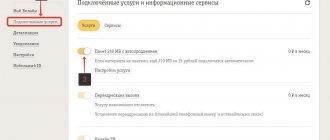Where do paid content subscriptions come from on your phone, how to cancel them and, most importantly, how to return the money written off by the operator? Let's talk!
The problem of paid operator subscriptions is still relevant. The Law “On Communications” is changing, subscribers are suing, but no, no, and they will find that they have another service that they did not connect, but are still forced to pay for it. And sometimes such services appear not even by accident or through negligence, but as a gift: here’s a great option for you, subscriber, use it for free! But not for long... say, a week. And then, as in the fairy tale about Cinderella, the carriage turns into a pumpkin, the footmen into mice, and gift services become paid. Strange? Quite a common practice!
Be careful, promotion!
For consumers, the word “promotion” is most often associated with something good and enjoyable: an opportunity to try something new or buy more for less money.
And companies, including those in the telecommunications sector, are actively taking advantage of this. The subscriber is stuck on the tariff, doesn’t connect subscriptions, doesn’t watch movies on his phone, doesn’t replace the dial tone with a melody. If you don’t touch him or provoke him in any way, he’s unlikely to buy anything extra. And this is where promotions come to the aid of operators. One of the most common ways to persuade a subscriber to use a new service is to offer him to do it for free for a while, and then decide whether he needs it or not. Most often, two mechanisms are used here. In the first case, after the free period expires, the service is disabled and the subscriber receives a message about how to activate it on a paid basis. In the second option, after the free period, the service does not terminate, but tariffs are activated. According to the rules, in this case, before the service becomes paid, the subscriber receives a message with the cost and rules for providing the service, as well as information on how to disable it. It is clear that it is the second option that causes the lion’s share of negativity among users. After all, in order to “avoid” the additional tariffication, the subscriber needs to receive and read messages, understand the shutdown mechanism and take the necessary actions. But SMS are not always read on time, letters end up in spam, and turning something off right now can be inconvenient, and then it will be forgotten. In the meantime, tariffs will remain in effect.
The “People's Rating” of telecom operators is literally replete with such stories. Thus, one of the users of Banki.ru under the nickname PoupkinVassily talks about how he was surprised to notice a message about connecting to him from the operator Rostelecom. According to the user, he received a message that he had become a participant in the “Safe Internet” campaign, within which the service will be free until May 31, and then will cost 139 rubles per month. Having received the SMS on May 1, the user did not wait for the end of the free period and immediately disabled it in his personal account. “It turns out that Rostelecom arbitrarily (without any of my consent) connected me to this “promotion,” PoupkinVassily is surprised. “In the above example, all the rules were followed,” says the Rostelecom press service. — The subscriber was offered to test the product for free during the promotional period. The subscriber did not need this service, he went into his personal account and turned it off.” However, other users complain about being charged for this service and claim that they did not activate it. Examples can be seen, for example, here and here. By the way, in both cases, after contacting the company, the money was returned to the subscribers.
“In order not to miss a message about the promotion, you need to check whether messages from the operator are included in spam,” advise the Rostelecom press service. — The message always contains a link to the full terms and conditions of the promotion, including refusal to participate in it. You should always study the full terms and conditions of the promotion. Of course, at least once a month you need to log into your personal account to check the connected services and additional options, the correctness of charges, and disable unclaimed services.”
How to check the status of subscriptions?
There are several ways you can find out which subscriptions work on a number:
- Call technical support. The simplest thing you can do is call the Tele2 technical support hot number - 611. After the telesystem employee answers, tell him the purpose of your call and ask him to clarify the situation. Remember that a company employee may request private information, so before dialing the number, place your passport next to you.
- Provider's office. If the Tele2 office is within walking distance from you, you can find out the necessary information right on the spot (with your passport). By the way, here you can immediately deactivate unnecessary applications.
- Personal account or application for mobile devices. You can also find out information through Personal Account or a similar application. You can identify content from Tele2 here as follows:
- log in to your page;
- go to the “My options and services” category and view the list of connected subscriptions.
If you do not need any of the functions, you can deactivate them with the corresponding key.
- USSD request. You can check your subscriptions by sending a USSD message with a special code. To check, send the combination *144*1# from your mobile phone. After this, a response message will be sent to the cell phone with a list of paid services available on the number.
- Voice menu. The necessary information can also be obtained through the voice menu. To do this, dial *111# and then follow the audio instructions.
“I pressed something...”
VAS (from the English Value Added Services, additional operator services) is a rather interesting market.
These are all kinds of subscriptions, replacing a beep with a melody, radars and antiviruses. And almost every subscriber at least once accidentally found an option that, in his opinion, he did not enable. How does this happen? You can become the “lucky owner” of a subscription by accidentally clicking on a link, replying to an SMS, or calling a specific number. But perhaps the subscriber did not want to connect anything, he only planned to look at the conditions or simply clicked on the picture.
“The peak of disputes over paid subscriptions occurred in 2011–2013, which became the impetus for legislative clarification that additional services, technologically inextricably linked with mobile radiotelephone services, can only be provided with the consent of the subscriber,” says the head of the intellectual and information law practice of the legal group “Yakovlev and Partners” Anna Nikitova. — For this purpose, amendments were made to the law on communications in 2014: the subscriber’s consent must be expressed by performing actions that uniquely identify the subscriber and allow one to reliably establish his will to receive these services (clause 5 of Article 44 of the Federal Law “On Communications”). In connection with this formulation, the question arises: what actions can mobile operators interpret as an expression of will to receive a service?”
According to her, direct expression of will can be expressed, for example, as a response message or by entering the code indicated in the picture. “It is obvious that the subscriber must take specific conscious actions on the mobile device aimed at connecting to the corresponding content service. The absence of such should exclude the possibility of automatic debiting of funds from the subscriber’s account when making the transition. At the same time, following the link may only be the subscriber’s desire to get acquainted with the detailed terms of the service, and the decision on the need to purchase such a service has not yet been made,” the expert adds.
What is considered a conscious action is still not clear. Moreover, there are situations when there is a subscription, but there has been no action. As, for example, in the sensational story when “smart” garage doors with an MTS SIM card subscribed to newsletters.
Content manager and his responsibilities
A content manager is a specialist who is responsible for the preparation, selection and placement of various information materials on the site, and identifies tasks and directions in this area.
The content manager is responsible for preparing materials.
His responsibilities include:
- review of competitors' websites;
- clustering of the semantic core and isolating a group of queries, which then need to be placed in the text;
- creating product descriptions and texts for sections that attract customers’ attention;
- collecting images of products, making them unique (sometimes the content manager himself photographs the product and then edits it in special programs);
- publishing texts and photos in compliance with all markup requirements and writing meta tags;
- creating a website page on social networks and maintaining it;
- analysis of website traffic using data from statistical services Google Analytics and Yandex.Metrica;
- conclusions and decisions regarding the results of the analysis.
The subscriber is “sleeping” - debits are in progress
Let's imagine a situation: the subscriber uses the phone, does not receive any suspicious mailings or messages, periodically tops up the account, and does not particularly monitor the balance.
And then suddenly he finds out that he has some kind of infotainment services. How does this happen? Very simple. Not all services involve sending content. Let's take, for example, the service of replacing a beep with a melody. The subscriber himself does not hear this melody, he does not call himself. And his interlocutors may not tell about it. The subscription fee for this service is not very high; with high communication costs, you may not even pay attention to such an amount. And it takes quite a long time to pay for a service that you don’t even know about.
It also happens: a person activated the service, used it for some time, and then simply forgot to turn it off. Such subscribers are called sleeping. As a result, on inexpensive services they can lose quite a significant amount over time. So, even if nothing indicates that you have such services, do not be lazy to log into your personal account at least once a month and check if you have any new paid options.
Such a “sleeping” subscriber was a Banki.ru reader under the nickname tartarelin, a Beeline subscriber. He complains that infotainment services are constantly connected to him without his consent, and money is debited, but no content is received. However, the operator’s press service reported that the service was activated by the subscriber, and the sending of the corresponding message to them was recorded in detail. “On the last day of free use, the client was sent an SMS reminder that tomorrow the service will become paid, indicating the price and method of using the service,” the company said. According to the press service, the subscriber connected, to use which you need to follow the link. It seems that the subscriber did not see the SMS, did not go to the portal, and in the meantime the money was debited.
Methods of creation and who does it
Creating content depends on what level of working with your audience you are at: if you are just starting out, it is small; but the larger it becomes, the more attention and time will be required to efficiently complete all tasks in this area. In the second case, it’s worth starting to create a team to work with content.
Find professionals to whom you can entrust important tasks, and take charge of the project yourself. This way you can create content for it much faster with the help of those who will report to you.
The team includes editors, authors, and designers.
Content Marketing Team Composition:
- Chief Specialist.
- Chief Editor.
- Third party authors.
- Designers.
- Subject matter experts.
- Partners, clients, opinion leaders.
Nothing personal
There are also services that the operator connects, but there is no data about them in your personal account.
A user of our portal with the nickname Antilos found himself in this situation. According to him, he was connected to a package of Amediateki series for MegaFon.TV, and a total of 765 rubles were charged for the service. The subscriber complains that the charges are ongoing, the service is not displayed in the personal account, and it is not clear how to disable it. “Is the operator’s action legal and how can I get my money back that was blatantly written off by the operator?” — asks a Banki.ru reader. “A subscription to Amediateka is connected and managed through the MegaFon.TV application,” says the MegaFon press service. — Yes, indeed, the subscriber has a subscription to Amediateka since March 15. There was a promotional period - seven days free. From March 22, the package was paid according to the conditions - 17 rubles per day. The user activates all packages and content himself. In MegaFon.TV, when a client selects a package and clicks “Activate,” detailed information about payment appears (conditions and how to pay) and a “Confirm” button. After the client confirms the purchase of content, he receives an SMS with information: what and when he connected.”
The MegaFon press service also noted that the subscription is indeed not displayed in the personal account, since it is managed only in the MegaFon.TV application, in the “Expenses, top-ups and details” section. At the same time, in your personal account there is still information about the debiting of money: it is displayed as additional expenses with the note “MegaFon.TV”. In this case, the subscriber will not be able to return the debited money, since to connect to Amediateka you need to go into the application and make two clicks, which is unlikely to be done by accident. The operator considers this action to be conscious.
Summary
So now you know what content is. Let's summarize the above.
The content of a web resource is information presented in the form of text materials, images, video files, and audio recordings. The interest and involvement of users and the success of website promotion depend on the quality of content. Therefore, you should make it unique, useful, informative, truthful and competent.
In addition, since in addition to real people, content on sites is also evaluated by search engines, it must be optimized for SEO requirements.
What to do?
Anyone can voluntarily or unwittingly be subscribed to additional services.
It’s especially offensive if a decent amount of money is written off for them. If you find yourself in such a situation and are sure that you did not connect anything yourself, contact the operator and insist that you are right. Yes, you will have to be patient, but most likely you will get your money back. A simple request did not help - write a letter to the central office of the operator (if you plan to deliver it in person, prepare two copies so that your copy is marked with the incoming number and signed for delivery; if you send it by mail, choose a registered letter with acknowledgment of delivery). If this does not help (which is unlikely), you can go to court.
And of course, do not click on unclear links, do not respond to suspicious SMS and do not call back to unfamiliar numbers unless absolutely necessary. You can also connect a special content account from which debits for such services will be made. If you keep 0 rubles on this account, then services will not be connected.
In any case, keep track of write-offs and do not forget to log into your personal account at least once a month. Situations are different, but it is better to keep money under control.
Meaning
It will be even easier to understand the meaning if you know the literal translation, in this case from English.
Literal translation – content, content.
Of course, books also have content, but it is brief, and as for the Internet, we mean the full content. Agree, it is not always possible to tell from the content of a book whether it is interesting or not, useful or useless.
Therefore, the content of sites can only be judged by fully reading them.
If we talk about the second meaning of “filling”, then everything is more logical here. Everything that fills the site (page, blog, community) is content.











